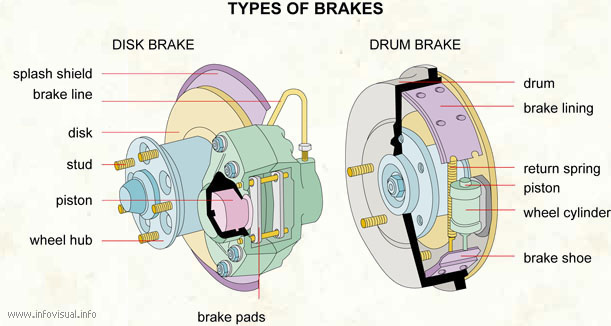Types of brakes

Drum brake: mechanism that slows and stops a car by fiction, by pression brake shoes against a drum.
Drum: cylindrical part attached to the wheel, against which the brake shoes are pressed to stop the car.
Brake lining: frictional part on the outside edges of the brake shoes.
Return spring: part of the brake mechanism that returns the brake shoes to their initial position.
Piston: cylindrical part that transmits the pressure to and receives pressure from the brake shoes.
Wheel cylinder: type of roller that applies a uniform pressure to the wheel then the brake is activated.
Brake shoe: part on which the brake lining is mounted.
Brake pads: part activated by the piston.
Wheel hub: central part crossed by the axel.
Stud: metal pin.
Disk: round, flat, piece of metal, pressed against the wheel to slow or stop the car.
Brake line: system liquid-transporting tubes.
Splash shield: protector that prevents dirt from fouling the braking system.
Disk brake: mechanism that slows and stops a car by friction, by pressing a disk against the wheel axel.
Photo :
EN : Bells
(ceramic)
FR : Cloche
ES : Campana

A bell is a simple sound-making device. The bell is a percussion instrument and an idiophone. Its form is usually an open-ended hollow drum which resonates upon being struck. The striking implement can be a tongue suspended within the bell, known as a clapper, a small, free sphere enclosed within the body of the bell, or a separate mallet. Bells are usually made of cast metal, but small bells can also be made from ceramic or glass. Bells can be of all sizes: from tiny dress accessories to church bells weighing many tons.